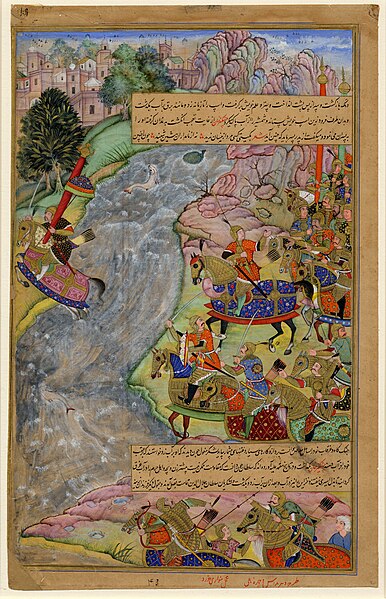Jalal al-Din Mangburni, also known as Jalal al-Din Khwarazmshah, was the last Khwarazmshah of the Anushteginid dynasty. The eldest son and successor of Ala ad-Din Muhammad II of the Khwarazmian Empire, Jalal al-Din was brought up at Gurganj, the wealthy capital of the Khwarazmid homeland. An able general, he served as second-in-command to his father in at least one battle; however, since he was the son of a concubine, he was challenged as successor by a younger brother, whose cause was supported by the powerful Queen Mother, Terken Khatun. Nevertheless, after the Mongol conquest of the Khwarazmian Empire led to his father's flight and death on an island in the Caspian Sea, Jalal-al Din gained the loyalty of the majority of Khwarazmian loyalists.
Uzbek 25 soʻm coin commemorating Jalal al-Din
Battle of the Indus: Jalal al-Din Khwarazm-Shah crossing the rapid Indus River on horseback, escaping Genghis Khan and the Mongol army.
Coinage of Jalal al-Din Mangubarni. AR Double Dirham. Qal 'a Nay mint
The Georgians (left) against the Khwarezmians (right) in the battle of Bolnisi in 1227. From the Tarikh-i Jahangushay manuscript created in Shiraz, Iran, in 1438.
Khwarazmshah was an ancient title used regularly by the rulers of the Central Asian region of Khwarazm starting from the Late Antiquity until the advent of the Mongols in the early 13th-century, after which it was used infrequently. There were a total of four families who ruled as Khwarazmshahs—the Afrighids (305–995), Ma'munids (995–1017), the line of Altuntash (1017–1041), and the most prominent ones, the Anushteginids (1097–1231). Like other contemporary Central Asian titles, such as Afshin and Ikhshid, the title of Khwarazmshah is of Iranian origin.
Coin of the Afrighid shah Sawashfan (ruled in the 8th-century)





